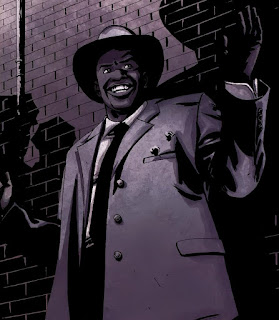Written by Mike Benson & Adam Glass. Art by Shawn Martinbrough & Nick Filardi.
Graphic Novella Review by Kerey McKenna.
I was sad to learn that Luke Cage, the bullet-proof Hero of Harlem, will not be renewed for another season on Netflix. Even if the last season did receive mixed reviews, as a whole I think it did one of the best jobs of realizing life in New York City in the Marvel Shared Universe. Hopefully Luke Cage, Misty Knight, and Night Nurse will return in other Marvel projects, possibly on the Disney exclusive streaming service coming down the pipe. In memoriam of Luke's removal from Netflix—and also because this is Noir November—I want to review Luke Cage Noir, a story that reframed him in a classic film noir paradigm, and incidentally first introduced me to him. I also want to explore some of the historical links between film noir and African American cinema.
In 2009 and 2010 Marvel comics released a limited run of Noir-themed comics. The books were mostly standalone mini-series of four issues each that restyled Marvel Characters like the Daredevil, Iron Man, and the Punisher in classic noir and pulp settings and tones. These stories tended to de-emphasize the fantastical, and transplant characters into 1930’s and 50’s noir mysteries or adventure pulps.
The Luke Cage story boils Luke down to his essence, a black man trying to bring justice to the people of Harlem when they have been ill served by lawful institutions and preyed upon by gangsters. The story takes place in 1930’s Harlem with Luke being released from a ten year stint at Rikers Island. Cage has become an urban legend as witnesses claim that the night of his arrest he managed to take two slugs to the chest...and get back up without a scratch on him.
Now Luke is out to settle old scores and solve the murders of both his woman and a white socialite. Along the way, the reader is taken along a classic hard-boiled detective tale, with machine gun dialogue, frame ups, and double crosses, all playing out in the vibrant and violent environs of Prohibition Era Harlem. Which I found refreshing because you don’t often see African Americans in such central roles or rounding out the majority of a cast in classic film noir.
It is well known that the Luke Cage character was created to chase the trend of the “Blaxploitation” films of the 60’s and 70’s. But what I didn’t know until I started researching this review is that the Blaxploitation movement itself tapped into an earlier cinematic tradition of black gangster/black protagonist crime and detective stories.
Even in the days of silent film, there were studios, or small divisions of studios, producing films for urban black audiences. Known collectively as “Race Films,” they were silent films and later talkies that featured not only predominantly minority casts but often all-minority casts. Like so many endeavors of the time, this nascent black cinema was kept separate and unequal from the mainstream. But unlike mainstream Hollywood, Race Films gave black and mixed-race actors a wide variety of roles over as many genres as shoestring budgets would allow. And yes, there were Race Film mystery and gangster movies. Sadly, because they received limited distribution, only a small fraction of those films were properly archived and tended not to be prioritized for restoration. And all too often, being B movies, they couldn’t afford the more experimental shooting techniques that came to epitomize the film noir canon.
With Luke Cage Noir, we come full circle. It's practically a reconstruction of the Race Film gangster noir stories. But rendered in pen and ink, rather than on the silver screen, and with the corporate muscle of Marvel Comics behind it, it is free of the earlier genre’s artistic handicaps. The creative use of shadow and color by the art team grant a style that the B movie Race Films could rarely afford. It is a great graphic novella, both for those who know The Hero of Harlem through the Netflix series, and for fans of classic hard-boiled detective stories who don’t want a bunch of garishly dressed superheroes running all over the place.
To my knowledge, since the original launch of the noir concept, Marvel hasn’t done much with it—with one notable exception. Stay tuned for my post on the one Marvel Noir hero who continues to appear in comics, cartoons, and video games—and is set for a big screen appearance later this year.
Kerey McKenna is a contributing reviewer to Nerds who Read and SMOF for the annual Watch City Steampunk Festival. Check it out at www.watchcityfestival.com.




No comments:
Post a Comment